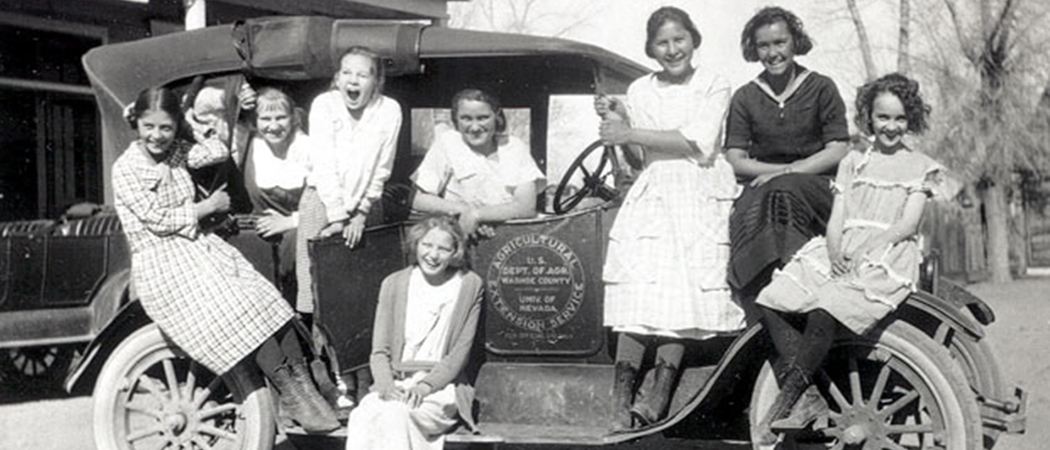Since the Smith-Lever Act established the nationwide Cooperative Extension system in 1914, University of Nevada Cooperative Extension has been a part of Nevada life, presenting research-based knowledge and programs to address critical community needs. This county-state-federal partnership provides practical education to people, businesses and communities in all 17 Nevada counties. If you have ever been involved in a 4-H youth activity or had a question answered by a Master Gardener, you have been touched by one of Cooperative Extension's more than 130 educational programs in the areas of children, youth and families; horticulture; health and nutrition; agriculture; natural resources; and community development.
Governor Brian Sandoval has proclaimed May 8, 2014 "University of Nevada Cooperative Extension in Day" to commemorate the signing of the Smith-Lever Act that established the organization and its 100 years of work in Nevada communities across the state. He also offered remarks on his own experience in the organization's 4-H program in a taped message that is part of a short video commemorating the organization's centennial.
"The 4-H Program taught me responsibility, leadership and gave me lifelong skills," he said. "In fact, it was my participation in 4-H that led me to buy my very first car - a Volkswagen bug. My brother and I spent every morning feeding and tending to our lambs."
"Our role has definitely expanded through the years," Mark Walker, Dean of the College, said. "We're now doing things like experimenting with use of drones to help manage natural resources, and STEM education has become a big emphasis in our 4-H programs, with things like 4-H Rocketry Clubs. In his videotaped message, Governor Sandoval said that our founders back in 1914 would be amazed at what Extension has become today. I think he's right."
Way before Gov. Sandoval benefitted from Cooperative Extension's 4-H Program, the organization was hard at work in the state. During both World Wars, Cooperative Extension's contributions increased as it trained Nevadans to meet the high demands of food production preservation and ingenuity, and later fire safety to protect food supplies. The 4-H Youth Leadership Development Program rapidly expanded as it taught boys and girls home economics, gardening, animal husbandry, canning and more. Today, 4-H continues to teach leadership, citizenship and life skills to nearly 50,000 Nevada youth ages 5 to 19 each year, through activities such as practicing robotics and raising animals, with an emphasis on STEM (Science, Technology, Engineering and Math) education.
After the wars and moving into the 60s and 70s, Cooperative Extension continued to grow and adapted its programs to meet the needs of an increasingly urbanized Nevada. In 1972, its Master Gardeners Program began providing free, research-based horticulture information specific to Nevada's challenging soils and climate to home gardeners across the state. Today, Nevada's more than 615 active Master Gardeners, who receive intense training in plant-science skills, volunteer in more than 30 community gardens, teach workshops, educate at farmers markets and schools, and provide information to about 87,000 gardeners annually.
As Cooperative Extension approached the turn of the century, it helped the state cope with new challenges. Cooperative Extension Natural Resource Specialist Ed Smith created the Living With Fire Program to collaborate with firefighting agencies and others to teach homeowners how to live more safely in Nevada's increasingly high wildfire-hazard environments. Since the program began in 1997, 19 other states have adapted Living With Fire educational materials to use in their own states. The program also was awarded the APLU's (Association of Public and Land-grant Universities) sole National Excellence in Extension Award in 2006.
In fact, University of Nevada Cooperative Extension is the only Extension in the country to have garnered the national award twice since the award's inception in 2006. The award was presented to Nevada's Youth Development Specialist Marilyn Smith, whose program efforts such as "Project MAGIC" assist at-risk and rural youth and families in 2008. University of Nevada Cooperative Extension also received the APLU's only other national Extension award, its National Extension Diversity Award, in 2011, for its "People of the Land" Program that trains agricultural producers to help Native Americans strengthen sustainable agriculture and natural resources management on reservations.
"A big part of our success is being adaptable and being able to reach and serve diverse populations," Walker said. "We have a proud tradition of being the 'go-to guys' in the small, rural communities like Elko and Caliente, but we are also very active in our large, urban centers like Las Vegas and Reno."












